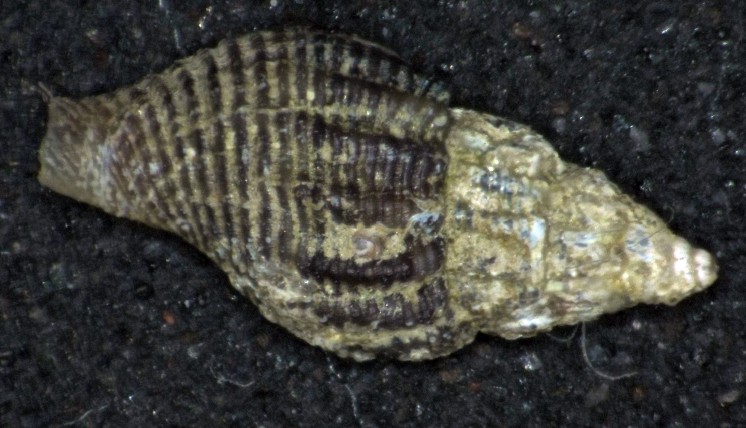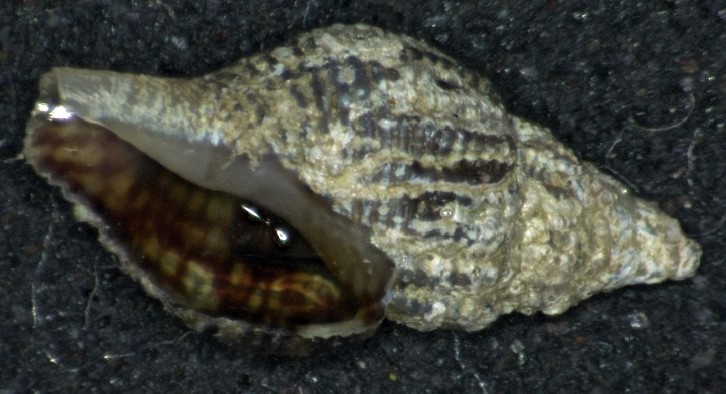Searlesia dira (Reeve, 1846)Common name(s): Dire whelk, Spindle shell, Spindle whelk |
|
| Synonyms: Kelletia dira, Searlesia dira |  |
| Phylum Mollusca
Class Gastropoda Subclass Prosobranchia Order Neogastropoda Suborder Rachiglossa Family Buccinidae |
|
| Lirabuccinum dirum from Sares Head. Total length 3.9 cm | |
| (Photo by: Dave Cowles July 2005) | |
How to Distinguish from Similar Species:_Acanthina spirata also has dark spiral ridges but is less elongated and has a distinct tooth on the outer lip of the aperture; Nucella canaliculata has similar spiral ridges but is less elongated and the whorls are separated by a deep groove.
Geographical Range: Chirikof Island, Alaska, to Monterey, CA. Abundant in British Columbia, Washington and Oregon; spoty in California. Said to be the commonest littoral snail in rocky shores of N. British Columbia.
Depth Range: Mostly intertidal (but also on Cobb Seamount at 35 m depth)
Habitat: Rocky shores; lower edges of rocks in gravel or mud in bays. In the San Juan Islands it was more abundant in rocky areas with moderate to substantial relief and wave exposure (Louda, 1979).
Biology/Natural History: A feeding generalist, predatory or mainly scavenging. Prey include Littorina (L. sitkana),limpets, barnacles, chitons, worms, and other animals; specializing in finding and eating injured animals which it often eats without drilling into the shell of (it does not seem to be able to drill into shells). Several chiton species are especially eaten, especially after they have experienced extended air exposure during summer daytime minus tides (Louda, 1979). Readily eats carrion such as dead crabs or fishes. Proboscis can extend the length of the shell. May extend proboscis to digest worms in their tubes, or to feed on prey that are being eaten by the everted stomach of Pisaster ochraceous. Predators include the seastars Orthasterias koehleri and Leptasterias hexactis, and Barrow's Goldeneyes (Bucephala islandica). Hatchling snails are eaten by hermit crabs Pagurus hirsutiusculus and by purple shore crabs Hemigrapsus nudus. It may be parasitized by the trematode Cercaria searlesiae Miller, 1925. The slipper snail Crepidula adunca may be found living on the shell. In muddy bays, this shell is a favorite of the hermit crab Pagurus granosimanus (but not of P. hirsutiusculus).
In his dissertation, Seavey (1977) reports that on the Oregon coast it takes approximately 16 months for eggs to mature in this species before laying. Spermatogenesis occurs throughout the year. in males. Spawning begins in October and November in Oregon.
Females deposit low, convex egg capsules in clusters on rock walls of crevices from September to May. Most of the eggs in a cluster ("nurse eggs") do not develop fully and are used as food by the veliger larvae that do develop. Rivest (1983) concluded that the nurse eggs were genetically determined and that the average ratio of nurse eggs to fertile eggs was characteristic of a particular female, but the ratio in different eggs laid by the same female nevertheless varied. Embryos that ate more nurse eggs hatched at a larger size. Egg capsules of this species are laid months before the eggs hatch.
This species does not migrate with the tides. Larger individuals are more common in the lower intertidal. May live 15 years.
| Return to: | |||
| Main Page | Alphabetic Index | Systematic Index | Glossary |
References:
Dichotomous Keys:Flora and Fairbanks, 1966 (as Searlesia dira)
Kozloff 1987, 1996 (as Searlesia dira)
Smith and Carlton, 1975 (as Searlesia dira)
General References:
Brusca
and Brusca, 1978
Harbo,
1997
Harbo,
1999
Johnson
and Snook, 1955
Kozloff,
1993
McConnaughey
and McConnaughey, 1985
Morris,
1966
Morris
et al., 1980
O'Clair
and O'Clair, 1998
Ricketts
et al., 1985
Scientific
Articles:
Lloyd, Margaret Champlin, 1971. The biology of Searlesia dira (Mollusca: Gastropoda) with emphasis on feeding. Ph.D. dissertation, University of Michigan. 97 pp.
Louda, S.M., 1979. Distribution, movement and diet of the snail Searlesia dira in the intertidal community of San Juan Island, Puget Sound, Washington. Marine Biology 51: pp. 119-131
Rivest, Brian R., 1983. Development and the influence of nurse egg allotment on hatching size in Searlesia dira (Reeve, 1846) (Prosobranchia: Buccinidae). Journal of Experimental Marine Biology and Ecology 69:3 pp. 217-241
Seavy, Donald K., 1977. Seasonal gametogenesis and egg laying in the prosobranch gastropods Nucella lamellosa, Nucella emarginata, Searlesia dira, and Amphissa columbiana on the Oregon coast. Ph.D. dissertation, Oregon State University. 179 pp. (As N. emarginata)
General Notes and Observations: Locations, abundances, unusual behaviors:

This view shows the operculum, the open siphonal canal, and the shiny, sinuous columella. Photo by Dave Cowles, July 2005

The dark spiral lines can very easily be seen on the inside of the outer lip of the aperture. Photo by Dave Cowles, July 2005

This indivudual was in a crevice on Swirl Rocks, July 2007.
| The tiny Searlesia dira individual below was only 7 mm long. Photos by Dave Cowles, August 2009 |
 |
 |
Authors and Editors of Page:
Dave Cowles (2005): Created original page